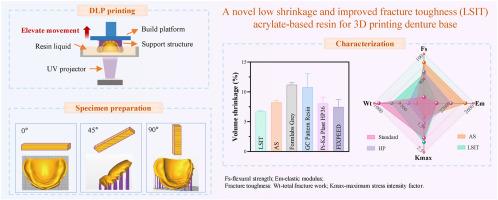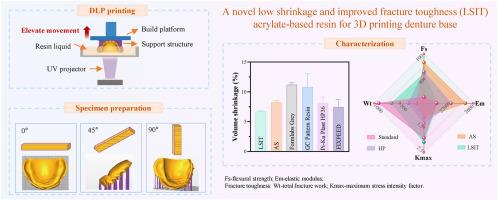一种新型低收缩率和提高断裂韧性(LSIT)的丙烯酸酯基树脂用于3D打印义齿基托
IF 4.5
2区 化学
Q2 POLYMER SCIENCE
引用次数: 0
摘要
目的数字光处理(DLP)打印义齿基托的应用受到光固化树脂精度差和断裂的限制。为了解决这些问题,提出了一种具有低聚合收缩率和提高韧性的新型树脂(LSIT)。方法采用DLP打印法制备新型LSIT树脂和ASIGA牙基(AS)树脂,并制备常规热聚合(HP)树脂。将LSIT树脂的物理性能、表面性能和机械性能与AS和HP进行了比较。还评估了LSIT和AS义齿基托的凹痕适应性,并使用CCK-8试剂盒评估细胞活力。结果LSIT树脂的聚合收缩率(6.70±0.18%)低于AS树脂(8.23±0.30%)。与HP和AS树脂相比,它具有更高的最大应力强度因子(Kmax = 2.08±0.30 MPa m1/2)和总断裂功(Wt = 646.61±129.61 J/m2),具有更好的断裂韧性。其抗弯强度和弹性模量符合ISO 20795-1:2013标准,并接近HP。此外,LSIT义齿基托在45°取向时表现出良好的凹痕适应,与AS相似。所有样品均未检测到细胞毒性。结论LSIT树脂具有较低的打印粘度、较高的断裂韧性和较小的体积收缩率,具有良好的打印精度,特别是在45°取向下。研究结果表明,LSIT树脂是解决3D打印义齿基托材料聚合收缩和脆性问题的一种有前景的解决方案。本文章由计算机程序翻译,如有差异,请以英文原文为准。


A novel low shrinkage and improved fracture toughness (LSIT) acrylate-based resin for 3D printing denture base
Objective
The application of digital light processing (DLP) printing denture base is limited by the photo-curing resin of poor accuracy and fracture. A novel resin with low polymerization shrinkage and improved toughness (named LSIT) was proposed to attack these issues.
Methods
The novel LSIT resin and commercial ASIGA Dentbase (AS) resin were prepared by DLP printing, and the conventional heat-polymerized (HP) resin was also fabricated. Physical properties, surface performance, and mechanical properties of the LSIT resin were compared to the AS and HP. Intaglio adaptation of the LSIT and AS denture base was also evaluated, and cell viability was assessed using a CCK-8 kit.
Results
The LSIT resin showed a lower polymerization shrinkage (6.70 ± 0.18 %) than the AS (8.23 ± 0.30 %). Compared to the HP and AS resins, it exhibited much more improved fracture toughness with higher maximum stress intensity factor (Kmax = 2.08 ± 0.30 MPa m1/2) and total fracture work (Wt = 646.61 ± 129.61 J/m2). Its flexural strength and elastic modulus matched the ISO 20795–1:2013 standard, and were closed to the HP. Moreover, the LSIT denture bases at 45°-orientation showed acceptable intaglio adaptation, similar to the AS. No cytotoxicity was detected in any sample.
Conclusion
The LSIT resin exhibited lower printing viscosity, higher fracture toughness, and minimal volume shrinkage, offering admirable accuracy, especially at 45°-orientation.
Clinical significance
These findings suggested the LSIT resin as a promising solution for addressing polymerization shrinkage and brittleness in 3D printing denture base materials.
求助全文
通过发布文献求助,成功后即可免费获取论文全文。
去求助
来源期刊

Polymer
化学-高分子科学
CiteScore
7.90
自引率
8.70%
发文量
959
审稿时长
32 days
期刊介绍:
Polymer is an interdisciplinary journal dedicated to publishing innovative and significant advances in Polymer Physics, Chemistry and Technology. We welcome submissions on polymer hybrids, nanocomposites, characterisation and self-assembly. Polymer also publishes work on the technological application of polymers in energy and optoelectronics.
The main scope is covered but not limited to the following core areas:
Polymer Materials
Nanocomposites and hybrid nanomaterials
Polymer blends, films, fibres, networks and porous materials
Physical Characterization
Characterisation, modelling and simulation* of molecular and materials properties in bulk, solution, and thin films
Polymer Engineering
Advanced multiscale processing methods
Polymer Synthesis, Modification and Self-assembly
Including designer polymer architectures, mechanisms and kinetics, and supramolecular polymerization
Technological Applications
Polymers for energy generation and storage
Polymer membranes for separation technology
Polymers for opto- and microelectronics.
 求助内容:
求助内容: 应助结果提醒方式:
应助结果提醒方式:


